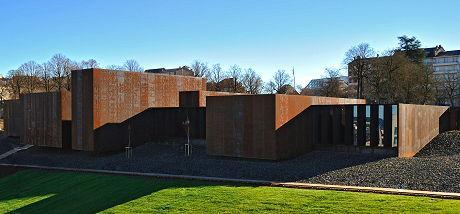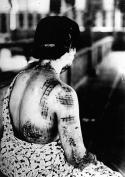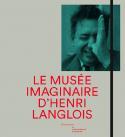Art Of The Day Weekly
#348 - from 29 May 2014 to 4 June 2014

Musée Soulages, RCR arquitectes, Photothèque Grand Rodez, photo Cédric Meravilles.
IN THE AIR
Soulages, a young 95-year old man
RODEZ – Painter Pierre Soulages, the most expensive and best-known French artist in the world, only paints in black, but he brightens up the canvas. Born in 1919, he now inaugurates his own museum in his native town. He claims he does not like monographic museums, so he had to do something original. Consequently, we have a small cascade of horizontal buildings in the middle of the central Foirail park, very near the cathedral. It is a “living” envelope in Corten steel, the material Richard Serra prefers, which corrodes and oxidises with time. In the interior, we have the detailed evolution of his art, including his figurative beginnings and his coloured periods, with a space for temporary exhibits. The opening poster mentions his ‘Outrenoirs’, scattered throughout museums all over the world. Soulages wishes to share the limelight and has scheduled other artists as well. Next to Kline or Motherwell, Soulages is indeed one of the great masters of black. But he insists, what he is interested in is not the colour black, but rather the light it reflects.
• The Musée Soulages (Jardin du Foirail, Rodez) opens on 30 May 2014.
EXHIBITIONS

Gonichi Kimura, Imprinted kimono pattern, towards 15 August 1945, Hiroshima, Musée pour la Paix ©Photograph by Gonichi Kimura, Courtesy of Hiroshima Peace Memorial Museum
War and art
LENS – In line with our times, on this centennial of WWI, the exhibition ‘Ravage’ at the M de Louvain shows the effects of war on art and heritage. The Louvre Lens pushes the investigation further by offering its own vision of the horrors of war. It goes back to Goya, includes Otto Dix and the ‘broken faces’ of 1914-1918 and finishes with the recent conflicts in the Middle East. The museum has its own theory, according to which artists, by stepping away from the traditional heroic vision, played a major role in the contemporary aversion of Western societies for war. Some strong works rhythm this process of awareness, such as an episode of the Berezina retreat by Boissard de Boisdenier or the photo of a woman from Hiroshima: the explosion engraved the motive of her kimono on her skin.
• Les désastres de la guerre at Louvre Lens, from 28 May to 6 October 2014.

Jacopo Ligozzi, Sheets of natural sciences/Mammals and reptiles, Mouse (Eliomys quercinus) and mole (Talpa sp.), circa 1577-1587, black stone and polychrome pigments on paper. Cabinet of drawings and prints, Uffizi Galleries, Florence.
Ligozzi, a genius to rediscover
FLORENCE – His nickname was Pittore universalissimo. It is true that Jacopo Ligozzi was over- talented. He was born in Verona in 1549, set up as a young man in Florence where he brilliantly succeeded at the court of the grand-duke, and led a workshop up to the eve of his demise, in 1627. Ligozzi was capable of set designs for parades as well as models of hard stone furniture or motifs for textiles, and was also a gifted painter. As a true man of the Renaissance, he accepted very diverse commissions, from the decoration of the grottoes of Boboli to the often chilling allegories on the sense of living. But today another aspect of his production further affects us: his illustrations of natural history. His fish, moles and wild herbs are fresh and lively, similar to the works of Dürer.
• Jacopo Ligozzi at the Galleria Palatina (Palazzo Pitti), from 27 May to 28 September 2014.
AUCTIONS

Lot 30 (Christie’s) Vasily Vereshchagin, The Pearl Mosque at Agra, oil on canvas, 150x200,7 cm, late 1870s/early 1880s. Estimate: £1,000,000-1,500,000.
Russia's hour
LONDON – The sales of national schools, which were so popular just a few years ago, have largely diminished. Sales of Greek or Spanish schools are very rare. Only Oriental, Latin-American and Russian art, carried by markets that pay well, still flourish. We have a nice example of this last aspect in a sale in London with the traditional competition between Christie’s and Sotheby’s on 2 May. The paintings are practically inaccessible but their simple presentation is a true temporary exhibit of beautiful art: at Christie’s a Peasant’s head by Malevich (€700 000), works by Lentulov or a beautiful Pursit composition by Alexandra Exter. At Sotheby’s seascapes by Aivazovsky, a series of royalty portraits from the XIXth century from Ivan Obolensky’s collection, the editor and business banker born in 1925, and two remarkable paintings by Vassili Vereshchagin (1842-1904), the leader of Russian Orientalists. These works belong to the collection of Vassar College at Poughkeepsie (New York), and meet the combined appetite of Russian and Middle East magnates. There is a strong possibility they will set a record price.
• Russian Art at Christie’s London on 2 June 2014
• Important Russian Art at Sotheby's London, 2 June 2014
ARTIST OF THE WEEK
Szafran, the genius of pastels
He is up there next Maurice Quentin de La Tour, Rosalba Carriera or Degas, the great masters of pastels. One could not limit though Sam Szafran (born in 1934) to this specialty, more than to being the painter of Parisian staircases or of the philodendrons that invade urban sun porches. But it is true that this artist has a remarkable C.V. He spent a part of his youth in Australia after part of his family died in the German camps, he experienced with hard drugs, met Artaud and Picasso, knew Giacometti; gave this old fashioned technique a modern aspect it had lost a long time ago and he loves to work by series that cover numerous years. Szafran, after being exhibited twice at the Fondation Gianadda, has his sixth exhibition at the Claude Bernard gallery, one of the most respected and difficult to get into in Paris. It has followed him since 1964.
• Sam Szafran is present at the galerie Claude Bernard (7, rue des Beaux-Arts, 75006 Paris), from 22 May to 5 July 2014.
OPENINGS OF THE WEEK

BOOKS
Henri Langlois, the cinema lover
His life can be read like a novel. He was born and lived in Smyrna, but had to leave it when the city was sacked by Ataturk’s army in 1923. Henri Langlois was only 8 years old but he always kept a strong attachment to his Oriental roots, even in his passport where he was described as being from “Asian Turkey”. According to his own words, he was ‘a good for nothing’. So he gave his heart and soul to cinema, founded movie theaters and the French Cinémathèque, the greatest important work of his life, with his friend Georges Franju. It was back in 1936, and he was barely 20 years old. But his crusade filled his whole life, until his death in 1977. The young thin man became a Hitchcock-type character, capable of getting support from Chaplin, Fritz Lang and Chabrol when Malraux had decided to fire him. The book accompanies an exhibition at the Cinémathèque, and traces the man’s combats to save silent movies, to keep the material souvenirs such as cameras, projectors, posters and his tireless vocation to make the world aware of the movies of all countries and confront them to one another. The Nouvelle Vague – from Rohmer to Truffaut – owed him a lot.
• Le musée imaginaire d’Henri Langlois, Flammarion, 2014, 240 p.,€ 45.


